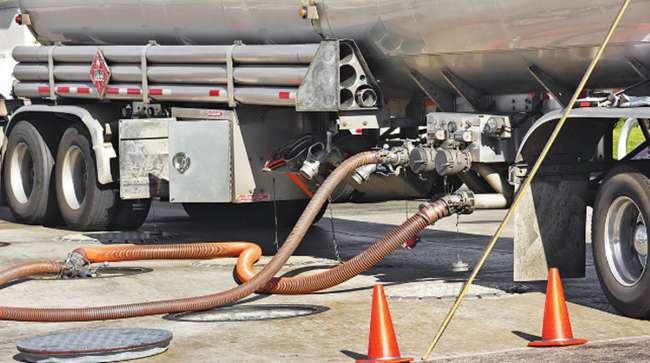Senior Reporter
Diesel Sheds 5.3¢ to Reach $4.836 a Gallon

[Stay on top of transportation news: Get TTNews in your inbox.]
The national average price for diesel fell another 5.3 cents Oct. 3 to reach $4.836 a gallon, according to the Energy Information Administration.
After falling for the fifth week in a row, the price of diesel is now the cheapest it has been since Feb. 28, when it was $4.104 a gallon. That was the week just prior to a historic 74.5-cent increase.
Diesel’s price fell in all 10 regions surveyed by EIA, with New England leading the way with a 9.3-cent drop.
The average price is less than $5 in every region now except California and the West Coast less California, after a 3-cent drop in the Central Atlantic brought the price there to $4.994 a gallon.
Diesel remains above $6 in California at $6.077 a gallon.
Nationally, diesel still costs $1.359 a gallon more than a year ago.
On-Highway Diesel Fuel Prices

EIA.gov
Gasoline, however, rose significantly on the national average (7.1 cents a gallon), even though it dropped in most regions. The price soared by 51.5 cents a gallon on the West Coast and by 42.1 cents a gallon in the West Coast less California.
Trucking’s main fuel appears poised to fall prey once again to geopolitical steps to cut global oil supplies, which typically raise the cost of a barrel of oil from which diesel and gasoline are refined.
OPEC+ recently agreed to the largest supply cut since 2020 — 2 million barrels a day compared with current output, although some members were already underproducing so the new cuts could be half the stated amount, according to reports.
And Russia warned it may reduce its own output of oil even further.
West Texas Intermediate futures Oct. 5 settled at $87.76 a barrel after members of the producer group agreed to the reductions. That was up $5.61 compared with a week earlier.
Ministers from the producers group defended the move as necessary to protect the oil industry and their own economies from the risk of a global slowdown.
A cut of 2 million barrels a day represents about 2% of global oil production, according to reports, and those cuts would fall more heavily in certain regions, including the United States.
In response, President Joe Biden said he could authorize more oil be released from the U.S. Strategic Petroleum Reserve, where it is stored in massive underground salt caverns along the Texas and Louisiana coastlines of the Gulf of Mexico.
Does the volatility of the crude supply and fuel prices at the pump affect attitudes about diesel’s viability as a key fuel moving forward?
One diesel advocate said absolutely not.

Schaeffer
“Fleets that are well-managed and have hedging programs (fuel discount cards and fuel surcharges, too) and futures kinds of considerations, for those guys this is just part of the normal course of business, the roller coaster that we all live on,” Allen Schaeffer, executive director of the Diesel Technology Forum, told Transport Topics. “Some days there’s really great prices to take advantage of and you’re ahead. Other days, you may be a little behind the curve, but you know how to play it. I think that’s just kind of what it is.”
With new fuels and technologies, he said, “it’s a brave new world there. We don’t really know what that looks like and how it will work out.”
At the end of the day, the folks buying trucks and thinking about their three- and five-year plans will obviously make decisions, he said. “I think for most companies, they are entering into a whole new era of what is it going to cost to run a truck. There is a lot of uncertainty there and it is easy to point to high diesel prices and say ‘oh this is a reason why folks are going to move to something else in the future.’ ”
That is definitely a contributing factor in their thinking, he added, “but I don’t say in and of itself it is going to play some outsize role. There are a lot of pieces here.”
Which is not to diminish the opportunity those alternative fuels and technologies might bring, Schaeffer said. “I just want to be clear about that. Certainly some of these new electrified vehicles and products are going to hold great promise for some companies in some situations in the right settings.”
Also, Schaeffer pointed to the broad recovery efforts underway in Florida and elsewhere after monstrous Hurricane Ian finally died out.
“The value of diesel is pretty clear. Folks are trying to find their way forward and you find a lot of diesel working to help do that,” he said.
On hand for the recovery are 20,000 or so utility trucks running on diesel to put poles back up and string the wires, generators that are mostly all diesels and construction equipment such as mobile water pumps that are using diesel, he said.
Want more news? Listen to today's daily briefing below or go here for more info:




